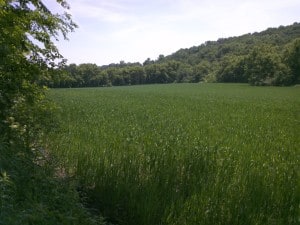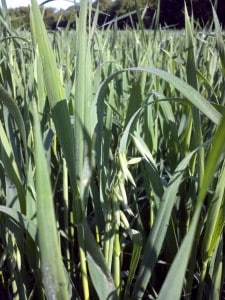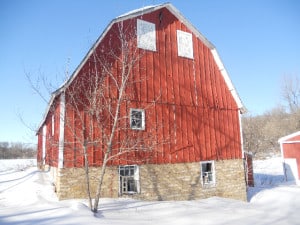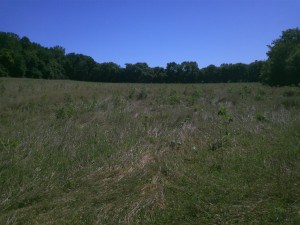Sogn Farm Project
Sold the oats. Got a check from the co-op. First money I’ve made farming. After paying for the combine and fuel I wonder what’ll remain.
This leads to a simple conclusion: commodity farming when you don’t have (or really want) commodity equipment isn’t practical. That’s OK. I wasn’t really thinking corn and beans on 25 tillable acres. Nope. Gotta go for some higher value products. CSA maybe, perennial fruits, or . . .
But here’s the rub: so far, most of the folks I’ve met who are into smaller-scale sustainable agriculture are thinking 2 to 10 acres – not 55 (or 25 tillable). So where will I find the right farmer who can create a workable, sustainable vision for this farm? I don’t know, but I’m going to keep looking!
At a delightful gathering of young farmers mixer last night, sponsored by Concrete Beet Farmers and The Greenhorns, and hosted by Andy and Betsy at Spring Winds Farm, I got to talk with a number of farmers about my vision for our farm in Sogn. When people asked me about what I’m doing right now, I described my job as doing what I can to make the farm as attractive as possible in order to attract the best possible farmer to the land.
Turns out that for 50 or 60 years the place hasn’t really been a working farm. The tillable acreage has been rented – often for conventional corn and beans – and the rest has been either a dump, escape from the city or just ignored. So my job now is to decide what things need doing to get the place ready to once again be an integrated, working and thriving farm. With only so many hours in the day (and limited brain and muscle power) I need to do a sort of triage to decide how to most effectively spend my time and resources to bring the place to a state that an excellent sustainable farmer will see and say, “I want to be here!”
So far, I’ve got the electricity in, am working on the well, have had tons of rubbish removed, begun organic transition on the tillable acres and begun work on a small farm office, repair of the old barn and creating a creek crossing from the farmyard to the main fields and hillsides. But are these the best choices?
I’d love to hear what others think. What are the most important things to do to prepare this place for successful sustainable agriculture? If you’re a farmer and want to pursue the small-scale, sustainable approach, what would want to see that would make you want to commit to a long-term relationship to this land?
All comments, suggestions and opinions are welcome! Just getting this far I’ve had enormous help from folks at the Land Stewardship Project, the Sustainable Farming Association and many helpful friends. Do you have a thought for me?
BTW, Thanks to the Wild Goose Chase Cloggers for the music, dancing and companionship at the mixer – it was great to have you there!
Straight line winds and heavy rains have taken their toll: the oats are bent over nearly to the ground and wedged into one another. I believe this is called lodging and you can see it in the photo. Around the edge of the fields, especially near the road, Minnesota’s newly identified invasive pest, wild parsnip has been giving me plenty to do just to keep it in check. You don’t want to mess with this stuff: if you get the juice on your skin and it gets exposed to sunlight you get a nasty burn. Ouch.
But things are coming along: the oats should be ready to harvest in a week or so, there is progress on plans for a farm office and repairs to the old barn and I’ve cleared many of the trees from along the creek where I hope to put a crossing so we don’t have to go the long way round from the barn to the fields.
The whole thing is overwhelming and exhilarating. I’m sure grateful for good friends who are helping in all kinds of ways.
The oats are up and doing beautifully, electricity is in and the well is working. Progress down on the farm!
With help from neighbors, oats were planted in most of the tillable fields along with alfalfa and mixed grasses. This is a first step towards organic transition: no treated seeds, no GM anything, no prohibited chemicals. They’re doing nicely as you can see in the photo.
 All together, there are about 24 acres in oats just now. After the oats and straw are harvested – likely late July or early August – the alfalfa should take off. At least, that’s the hope!
All together, there are about 24 acres in oats just now. After the oats and straw are harvested – likely late July or early August – the alfalfa should take off. At least, that’s the hope!
I never imagined I’d get so excited seeing oats grow! I’m thrilled. Go figger. Here’s an image of the oats, up close and personal so you can see the seeds developing.
 Maybe I’ll keep a bushel or two and see if I can make oatmeal, rolled oats or skirlie. But that’s for later. At the moment I’ve got more immediate jobs to do: gotta get the red barn solid, cleaned up and re-painted. Got to get a farm office sorted (with a working bathroom, I hope) and lots of thinking about the overall site plan. Where should I put a strawberry patch, raspberries, hops, asparagus or other perennials? What should I do about a crossing over the creek? And what about the gazillion boxelders and tons of buckthorn? So much to ponder.
Maybe I’ll keep a bushel or two and see if I can make oatmeal, rolled oats or skirlie. But that’s for later. At the moment I’ve got more immediate jobs to do: gotta get the red barn solid, cleaned up and re-painted. Got to get a farm office sorted (with a working bathroom, I hope) and lots of thinking about the overall site plan. Where should I put a strawberry patch, raspberries, hops, asparagus or other perennials? What should I do about a crossing over the creek? And what about the gazillion boxelders and tons of buckthorn? So much to ponder.
Good, though.

The picturesque Sogn Valley near Cannon Falls, Minnesota has seduced me. With no farming experience but a passion for sustainable agriculture we went and bought a 55 acre farm in this lovely area. The farm includes 25-30 acres of rich bottomland with a small creek running through it, the balance is south-facing woodland with old oaks, younger birches and, we’re told, lots of morel mushrooms. The fields have been rented for conventional corn and beans but this year I’m planting oats and alfalfa to begin organic transition. There are two barns but no dwelling at present, though there is one building right with the property.
We bought this land because I think it has enormous potential: the soil is excellent, it is within an hour of a major market, it is near a transport corridor (Highway 52 runs from the Twin Cities to Rochester) and not far from a lively college town, Northfield, the hillside offers excellent solar resource in addition to its historic oak savannah ecology. But how do I realize this potential? I’m not a farmer, I’m a musician and scholar (ethnomusicolgy – go figger . . .). My dream is to find some folks who want to help creating a thriving, sustainable, resilient farm on this land integrating the fields, stream, woods and buildings. I don’t know what the best crop choices will be, but I suspect that a variety of products will yield the best results: some critters grazing, small fruits or berries, wood for heat, small grains, CSA or market vegetables, maybe hops for the burgeoning local brewing scene. I’m expecting some serious trial and error!
We’ve only owned the land a few weeks so I’m overwhelmed with ideas and projects. But in the end I hope this will be home to a farm family of some sort that will thrive and, in time, take ownership of all or part of the enterprise. There are many, many steps between here and there but that’s my dream. I wonder if there is someone out there who’d like to play in this sandbox . . .
Just heard that our offer for this property has been accepted. 55 acres – 39 tillable – in the Sogn Valley, about an hour south of Minneapolis near Cannon Falls.
Adventures to come!
Welcome to youngwalser.net, Bob Young Walser’s internet outpost. Based in Minneapolis, Minnesota I hope to chronicle unfolding responses to the challenges of Energy Uncertainty (aka Peak Oil), Climate Change and Economic Change in the heartland of the U.S.A. With an eye to the ideas of Transition being developed in England by Rob Hopkins and others, I wonder what the evolution of life in the Midwest will look like and I hope to celebrate the successes of that process as well as to recognize the challenges. I agree with Chris Martenson when he says that the next 20 years will be nothing like the last 20 years. We shall see . . .
- « Previous
- 1
- …
- 6
- 7
- 8

